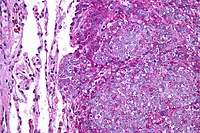
Photo from wikipedia
Periosteal new bone formation (PNBF) is a common finding in a large spectrum of diseases. In clinical practice, the morphology and location of periosteal lesions are frequently used to assist… Click to show full abstract
Periosteal new bone formation (PNBF) is a common finding in a large spectrum of diseases. In clinical practice, the morphology and location of periosteal lesions are frequently used to assist in the differential diagnosis of distinct bone conditions. Less commonly reported is the presence of PNBF on the ribs. This contrasts with the data retrieved from the study of skeletonized human remains that shows a high frequency of cases and a strong, albeit not specific, association between periosteal rib lesions and pulmonary conditions (e.g. tuberculosis). Despite that, an overall disagreement regarding the specificity and non‐specificity of periosteal reactions exists in the study of dry bone remains. The insufficient number of clinical models exploring the morphology and the pathophysiology of PNBF's and the lack of systematic studies of pathological samples with a known diagnosis are claimed as major reasons for the disagreements. This study aimed to describe and compare the macroscopic and the histomorphologic appearance of periosteal rib lesions and to discuss their usefulness as diagnostic indicators. To pursue this goal, an assemblage of 13 rib samples (males = 11, females = 2, mean age‐at‐death = 36.6 years old) was collected from the Luis Lopes Skeletal Collection (Museu Nacional de História Natural e da Ciência, Universidade de Lisboa, Portugal). The assemblage belongs to individuals who died from pulmonary‐TB (group 1), non‐TB pulmonary infections (group 2) and other conditions (group 3). Prior to sample preparation, the ribs were visually inspected and the PNBF described according to its thickness, the degree of cortical integration and the type of new bone formed (e.g. woven, lamellar or both). After sampling, each bone sample was prepared for histological analysis under plane and polarized light microscopy. Macroscopically, the results showed no differences in the new bone composition between cause‐of‐death groups. Only slight differences in the degree of cortical integration, which was most frequently classified as mild to high in the pulmonary‐TB group, were observed. Histologically, no distinguishing features were identified by pathological group. However, new bone microarchitectures were observed compatible with (1) acute, fast‐growing processes (e.g. spiculated reactions), (2) long‐standing processes with a rapid bone formation (e.g. appositional layering of bone) and/or (3) chronic, slow‐growing processes (e.g. layers of compact lamellae). To some extent, these distinct rates of disease progression resonate with the cause‐of‐death listed for some individuals. Despite the small sample size, the results of this investigation are in agreement with previous studies, according to which the macroscopic and histological appearance of periosteal formations are not specific for a particular pathological conditions. Nevertheless, the results support the conclusion that the morphology of periosteal lesions is a good biological indicator for inferring the rate of progression and duration of pathological processes. This study provides important reference data regarding the histomorphology of periosteal lesions that can be used for comparative purposes, as well as to narrow down the differential diagnosis in unidentified skeletal remains.
Journal Title: Journal of Anatomy
Year Published: 2019
Link to full text (if available)
Share on Social Media: Sign Up to like & get
recommendations!